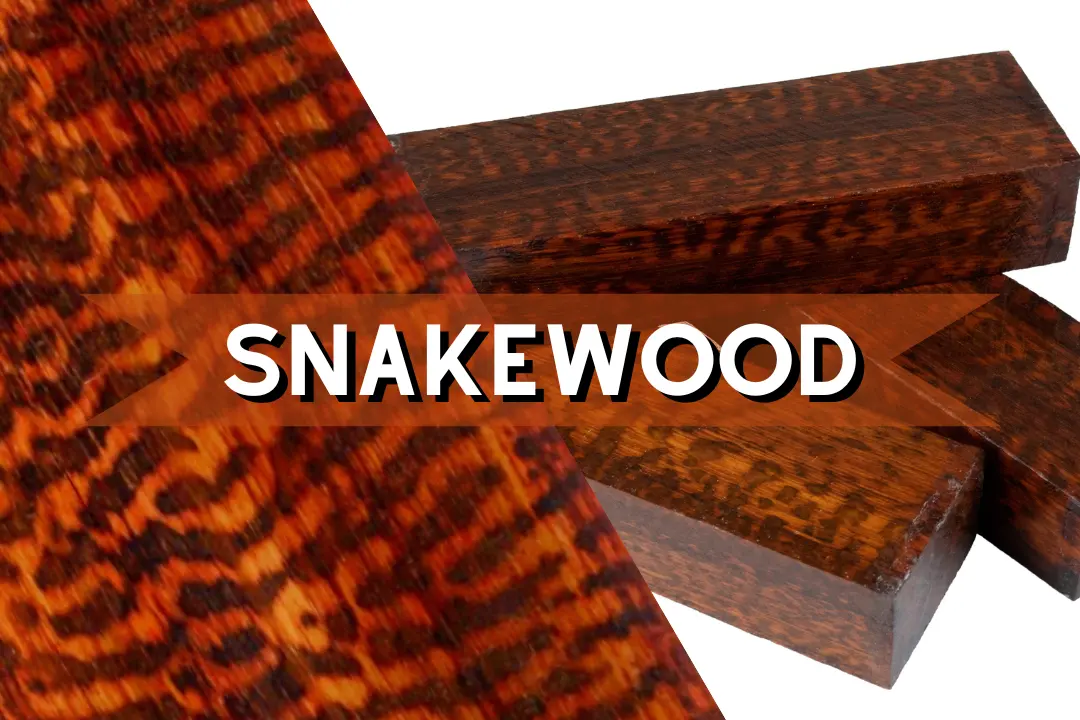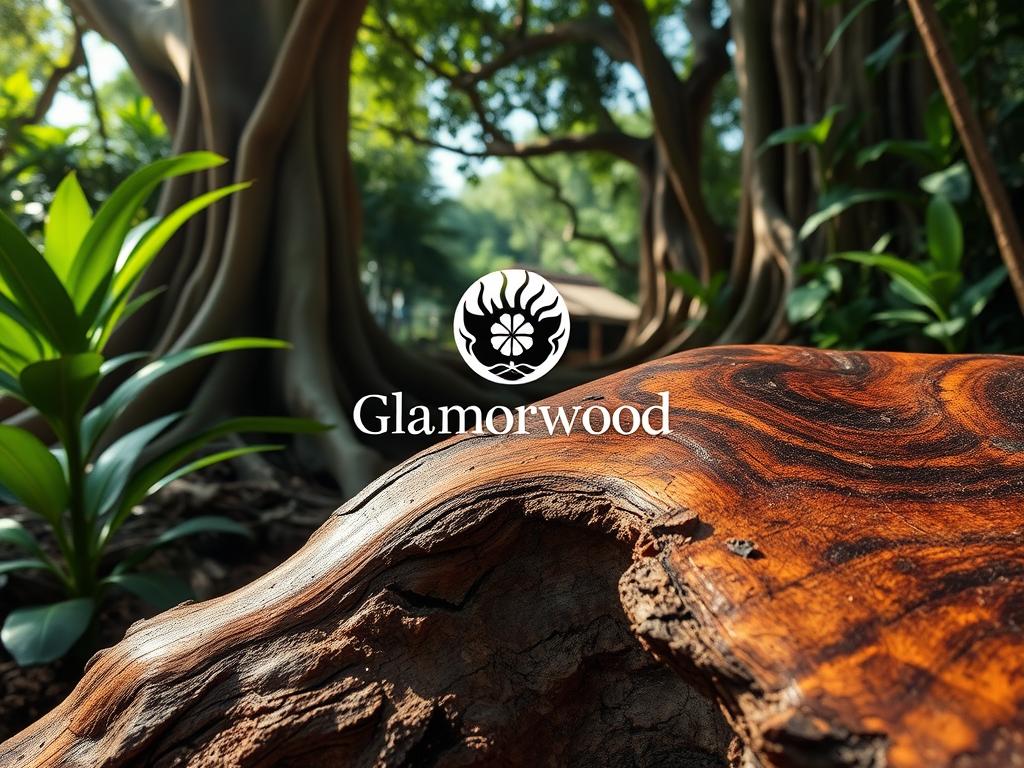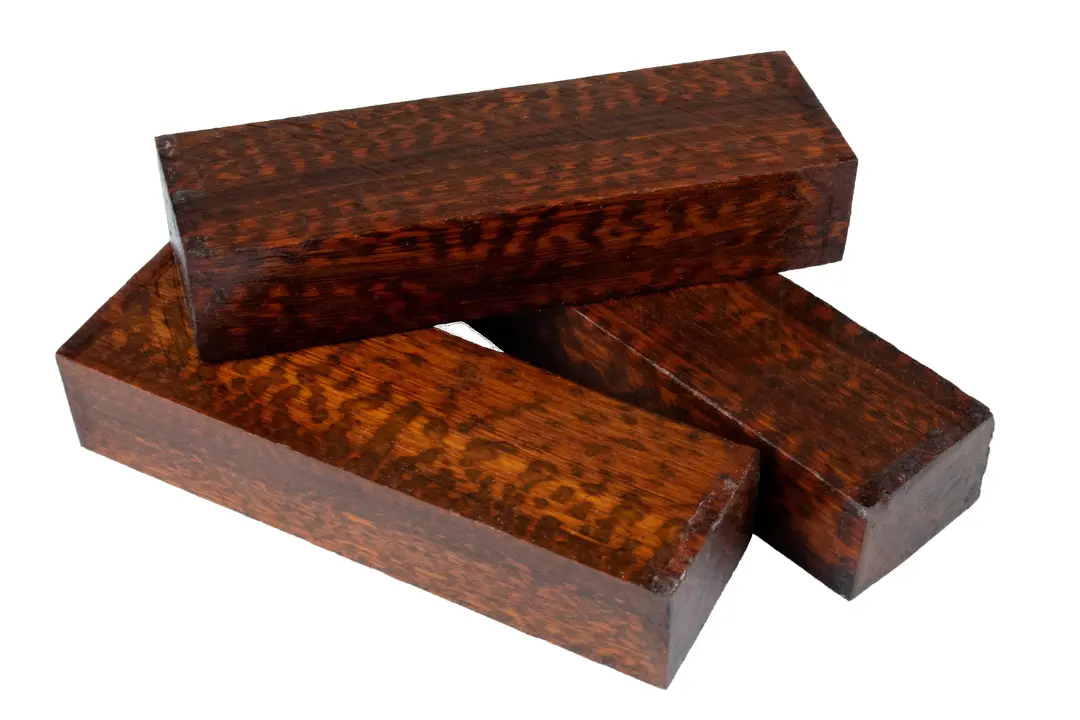
Snakewood: Unveiling the Secrets of This Captivating Hardwood

Did you know snakewood can cost over $200 per board foot? It’s one of the priciest hardwoods globally. This wood is famous for its unique patterns and durability. It has a rich history and a striking look that makes it stand out.
We’ll dive into the world of snakewood. We’ll look at its origins, what makes it special, and where it’s used. We’ll also compare it to other hardwoods.
Table of Contents
What is Snakewood?
Snakewood comes from the Brosimum guianense tree. It’s known for its unique wood. The heartwood looks like snake scales, making it very appealing.
The color of snakewood ranges from light yellow to reddish-brown. It often has darker patches. Its density and weight make it valuable.
The snakewood tree has a thin trunk. This leads to smaller, irregular logs. Handling these logs can be tricky because they easily splinter.
This Exotic Hardwood is very expensive because it’s rare and beautiful It’s used in special items like violin bows and fine furniture.
| Wood Characteristics | Values |
|---|---|
| Average Dried Weight | 75.7 lbs/ft³ (1,210 kg/m³) |
| Janka Hardness | 3,800 lbf (16,900 N) |
| Specific Gravity (Basic, 12% MC) | 0.96, 1.21 |
| Crushing Strength | 17,260 lbf/in² (119 MPa) |
| Modulus of Rupture | 28,270 lbf/in² (195 MPa) |
| Elastic Modulus | 3,364,000 lbf/in² (23.2 GPa) |
| Shrinkage (Radial) | 4.7% |
| Shrinkage (Tangential) | 6% |
| Shrinkage (Volumetric) | 10.7% |
| T/R Ratio | 1.3 |
The Origins of Snakewood
Snakewood has a fascinating history tied to its unique features. It’s often talked about in this speckled wood history discussion. Indigenous communities first used it for practical needs, long before its beauty was noticed by artists worldwide. The origins of snake wood are rooted in tropical areas, where it’s been valued for centuries.
A Brief Historical Overview
Snakewood was first valued for its usefulness, then for its stunning grain and deep color. As trade grew in the New World, its beauty sparked global interest. This led to a deeper understanding of its cultivation and export, blending with the history of wood craftsmanship.
Geographical Distribution
The snakewood tree thrives in the Amazon rainforest’s tropical climate. Brazil, Suriname, and Guyana are its main habitats. These places offer the perfect conditions for its growth, making it a rare and sought-after hardwood.
Humans have also introduced this rare wood to Florida and the Caribbean. Seeds floated across saltwater, expanding its range. Its geographical spread shows its adaptability and ongoing appeal.

Characteristics and Properties
Snake is a wood that many artisans and manufacturers love. It has unique qualities that set it apart from other hardwoods. This makes it a prized material.
Physical Attributes
Snakewood’s wood grain has a striking pattern. This pattern makes it stand out and adds to its appeal. The wood’s colors range from dark brown to deep shades, with clear linear patterns.
The average dried weight of snakewood is about 76 lbs/ft3. This makes it a dense wood. The tree can grow up to 65-80 ft tall, with trunks 6-12 in wide. Its grain structure adds beauty and makes it stable against warping and shrinking.
Durability and Density
It’s known for its durability. It has a specific gravity of 1.21 and a Janka hardness rating of 3,800 lbf. This makes it very resilient for tough uses.
Its density helps it last longer, even in harsh conditions. This durability, combined with its beauty, makes snakewood perfect for luxury items.
Uses in Craftsmanship
Snakewood is special in the world of craftsmanship. It’s known for its unique qualities that make it perfect for many uses. This hardwood is not just beautiful but also strong and durable.
Musical Instruments
Snakewood is great for making musical instruments. It’s often used in violin bows and guitar fretboards. The wood’s density gives instruments a bright and expressive sound.
Its stability means instruments made from this Patterned Hardwood last a long time. This makes it a top choice for high-quality musical tools.
Applications in Fine Furniture and Decor
It’s also loved for its striking look. It’s used in making beautiful furniture and decor. Artisans create stunning pieces like tables and cabinets.
These items are not just useful but also works of art. This Luxury Timber’s unique patterns and colors add luxury to any space.
Use in Knife Handles and Tools
Snakewood is also used for knife handles and tools. It’s tough and looks great. The wood’s resistance to wear means the handles last a long time.
This shows how versatile snake wood is. It turns everyday tools into special, handcrafted items.

The Workability of Snakewood
Snakewood is a challenging wood to work with, thanks to its high density and unique grain pattern. These traits make it harder to work with than softer woods. Woodworkers need special tools and techniques to handle this exotic hardwood effectively.
Shaping, cutting, and finishing this wood requires patience and skill. Its Janka hardness rating of 3,800 lbf shows it’s very tough. You need strong tools to avoid damage and keep your work precise.
Many woodworkers love this wood for its beautiful colors and grain patterns. Its durability and unique look make the hard work worth it. The end result is stunning, showing off the wood’s beauty.
| Attribute | Value |
|---|---|
| Main Color Group | Variegated |
| Grain Pattern | Figured |
| Average Dry Weight per Board Foot (LB/BF) | 6.3 |
| Average Dry Weight per Cubic Meter (KG/M3) | 1210 |
| Janka Hardness (LBF) | 3800 |
| Density (kg/m3 dry) | 1210 |
| Specific Gravity | 0.96 – 1.21 |
| Radial Shrinkage % | 4.7 |
| Tangential Shrinkage % | 6.0 |
| Gluing | Difficult |
| Durable | High |
This table gives woodworkers key information about snakewood. It helps understand the wood’s workability in projects.
Comparative Analysis
Snakewood stands out when compared to other hardwoods. It has unique looks and uses. This analysis will look at snakewood against bloodwood and ebony. We’ll also compare their strength and cost.
Snakewood vs Bloodwood
Snake and bloodwood are both special in their own ways. Snake is known for its tough nature and beautiful grain. Bloodwood, on the other hand, has a deep red color that catches the eye.
Both woods are great for high-quality woodworking. They offer different looks that appeal to different needs.
Snakewood vs Ebony
Snake and ebony wood have different features. Snake is denser and often cheaper than ebony. Ebony is famous for its black color and smooth finish.
Snake wood has unique patterns that many artists love. Ebony, with its elegance, is a favorite for some. It depends on what you’re looking for in your project.
Strength and Density Comparisons
Snakewood is very strong and dense. It has a density of 75.7 lbs/ft3. This makes it perfect for projects that need to last a long time.
Other woods like black ironwood and Lignum Vitae are also very dense. But this wood is among the top in terms of strength.
Cost Considerations
The cost of snakewood is high because it’s rare and in demand. While it’s expensive, its unique look and quality make it worth it for skilled craftsmen.
Knowing the prices of different woods helps craftsmen choose the right one for their projects. It’s all about finding the best material for your needs.
| Wood Type | Density (lbs/ft3) | Cost Status | Aesthetic Feature |
|---|---|---|---|
| Snakewood | 75.7 | High | Intricate grain patterns |
| Bloodwood | 60.5 | Moderate | Rich crimson color |
| Ebony | 80.0 | Very High | Deep black color |
Conclusion
Snakewood is not just a beautiful hardwood. It’s also very strong and durable. Its unique features, like a bending strength of 241 N/mm² and hardness of 196 N/mm², make it popular among woodworkers and collectors.
This Exotic Hardwood is used in many ways, from making musical instruments to fine furniture. This shows its versatility and high value in woodworking.
The way snake wood is harvested is impressive. It can yield 800 to 2,000 kg of wood from one tree. Each tree gives about 25 logs, with sizes ranging from 8 to 30 cm. This highlights the effort and traditional methods used to get this wood.
Knowing about snakewood’s qualities and uses makes it a highly valued material. It’s a symbol of beauty and function in woodworking. This conclusion emphasizes its worth, encouraging more exploration of its benefits in creating beautiful items.
FAQs
What is snakewood and where does it come from?
Snake wood is a rare hardwood from the snakewood tree, known as Brosimum guianense. It grows in the Amazon rainforest of Brazil, Suriname, and Guyana.
What are the unique characteristics of snakewood?
It has a unique look with patterns that look like snake scales. It’s very dense and heavy, making it durable and stable. It also doesn’t warp or shrink much because of its grain structure.
What applications does snakewood have in craftsmanship?
It’s great for making musical instruments like violin bows. It’s also used in high-end furniture, decorative items, knife handles, and woodworking tools.
How does snakewood compare to other hardwoods like bloodwood and ebony?
Snakewood is more durable and has a more detailed grain than bloodwood. It’s heavier and cheaper than ebony, offering a unique look that many people like.
What is the workability of snakewood?
Working with snakewood is hard because it’s very dense and has an interlocking grain. Woodworkers need special tools and techniques. But, the results are worth it, showing off its beauty and durability.
Why is snakewood considered a valuable hardwood?
Snakewood is rare, beautiful, and durable. It’s more expensive than other hardwoods because of its unique qualities and the skill needed to work with it. This makes it popular among artisans and collectors.
What makes snakewood suitable for musical instruments?
It’s good for musical instruments because it’s dense. This makes the sound brighter and more expressive. It also stays stable in different environments, ensuring consistent sound.
What are the cost considerations when purchasing snakewood?
Snakewood is pricey because it’s rare and in demand. Even though it’s more expensive than many other hardwoods, its quality and beauty make it worth it for those who want the best.



